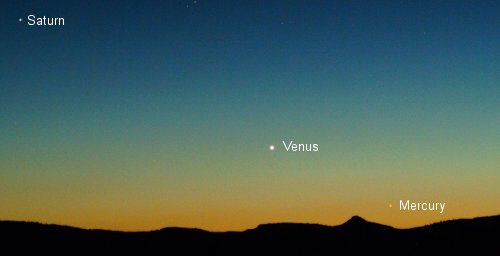[/caption]
Venus and Mercury are the two planets that orbit closest to the Sun. Mercury orbits at an average distance of 58 million km, while Venus orbits at a distance of 108 million km. Mercury takes 88 Earth days to complete an orbit, and Venus takes 225 days to orbit the Earth.
And as you’d probably guess, Venus and Mercury are the two hottest planets in the Solar System, but not in the order that you’d think. Even though Mercury orbits closer to the Sun than Venus, it lacks an atmosphere. The side facing the Sun is baked, with a temperature of 425 degrees Celsius, the side facing away from the Sun cools down to -193 degrees Celsius. Venus, on the other hand, has an incredibly thick atmosphere and traps the heat from the Sun. No matter where you go on the planet, the temperature on the surface of Venus is always 462 degrees Celsius.
The composition of Venus and Mercury is similar, they’re both terrestrial planets made of rock and metal. Mercury is more dense than Venus and thought to consist of 60-70% metal, with the rest rock. As mentioned above, Mercury lacks an atmosphere, while Venus has the thickest atmosphere of all the terrestrial planets. The temperatures and pressures are so extreme on the surface of Venus that spacecraft only last a few hours before being crushed and baked.
Both Venus and Mercury are within the orbit of Earth. This means that they’re always located near the Sun in the sky. Sometimes they rise before the Sun, and then fade away as the Sun rises, and sometimes they’re set after the Sun. They appear as the sky darkens, and then pass below the horizon within a few minutes. You need to have a clear view to the horizon to see Mercury, and know when to go looking. Venus, on the other hand can appear quite high in the sky, and is very bright. In fact, Venus is the brightest object in the sky after the Moon.
We have written many articles about both Venus and Mercury on Universe Today. Here’s an article about new images captured of Mercury by NASA’s MESSENGER spacecraft. And here’s an article about a potential way to colonize Venus.
If you’d like more information on Mercury, check out NASA’s Solar System Exploration Guide, and here’s a link to NASA’s MESSENGER Misson Page.
We have also recorded a whole episode of Astronomy Cast that’s just about planet Mercury. Listen to it here, Episode 49: Mercury.
References:
NASA Solar System Exploration: Venus
NASA Solar System Exploration: Mercury

